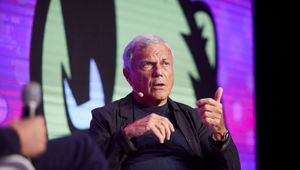
Why ASICS Is Finding Success as Sports’ Caregiver Brand

In January, many of us turn to exercise with the hopes of enabling some kind of outward physical change - losing weight or building muscle. But sports giant ASICS has an altogether more holistic approach to the benefits of being active, drawing together the latest science with boundary-pushing product innovation to help people feel better mentally as well as physically. Over recent years, its marketing has focused on the mental wellness impact of exercise, whether it’s their global State of Mind Index or prominent campaigns for World Mental Health Day.
The company’s corporate vision is to "create quality lifestyle through intelligent sport technology”. ‘Like a trusty pair of running shoes, the dynamic duo of wellness and technology is helping the brand run at full speed. 2022 has been incredibly successful for the business financially. It has defied market-wide issues like supply chain snaggles and continued covid lockdowns in parts of Asia to see continued growth in sales across North America, EMEA and Asia. That’s been driven, in part, by innovations like the lightest ever CO2E emission sneaker, but also a sense of clarity and momentum in its marketing.
According to Gary Raucher, head of product, marketing, and merchandising at ASICS EMEA, the evolution in the business’ marketing has played a ‘critical role’ in its success. “I think that we've always had very strong products, and now what we're doing is complementing those great products with great marketing,” he says. “I think that we're fortunate enough to truly be a purpose-driven brand. What we've been doing is going back to that founding purpose, and trying to bring that to life consistently in everything that we're communicating. And I think that that founding purpose is perhaps more relevant today than it's ever been.”
A History of Healthy Minds in Healthy Bodies
Indeed, when it comes to brands that have led where others have followed, ASICS is one that has been running ahead of the pack for so long that we perhaps haven’t noticed just how pioneering it really is, particularly in the realm of purpose.
Founded by Kihachiro Onitsuka, an office worker-turned-shoemaker, the brand takes its name from the Latin phrase ‘Anima Sana In Corpore Sano’... a healthy mind in a healthy body - and draws its raison-d’etre from Onitsuka’s belief that sport and exercise would be key to Japan’s recovery in the turbulence post World War 2. Fuelled by a belief in the values of sportsmanship and the impact sport can have in all aspects of life and society, Kihachiro Onitsuka had founded a purpose-driven business decades before that was a trendy marketing buzzword.
A Caregiving Brand When the World Needed It
That purpose even pre-dates the ASICS brand (which came to being in 1977), all the way back to the company’s foundation as Onitsuka Co. in 1949. But it’s a purpose that’s taken on a new poignancy in our over-stressed, burnt-out modern world.
Gary reflects that covid-19 has only intensified that. “Back in 2019, the World Health Organisation was already talking about stress and anxiety being a pandemic. And then covid came and only made things worse. We do a lot of work with Mind, a charity in the UK, they had done a study during the pandemic, saying that adults in the UK were more stressed than they had ever been in their lives. We saw that it became even more relevant, to try to get people to move and exercise because it was having a positive impact on their mental well being.”

That perspective was encapsulated in a recent campaign, ‘Dramatic Transformations’, created for World Mental Health Day 2022, by Golin. It skewers the ‘before and after’ pics favoured by diet mags that often show drastic weight loss or muscle gain. In this case, the campaign shows people like Love Island star Alex George and Strictly Come Dancing judge Motsi Mabuse before and after exercise. The transformation is subtle but profound - they’re standing taller, flushed and sweaty with health, with a look of satisfaction in their eyes.
This deeply-rooted mission marks ASICS out in the sportswear category. Gary explains that, when figuring out ASICS’ brand positioning, the team looked at what else was out there and found that most were either ‘ruler brands’ championing success at all costs or ‘hero brands’ lionising the sweat and pain of the hardcore grind. By contrast, ASICS quickly figured out that it was something else entirely - a ‘caregiver brand’.
“As a sports brand, of course we love to win, but winning for us shouldn’t come at all costs. Actually, the physical wellbeing and the mental wellbeing of our athletes and of our consumers is more important than any medal or any podium place. That was the shift in mindset,” says Gary. “There's an entire series of activities that we've been doing, ever since we really anchored ourselves back in our roots and said, ‘we are a caregiver brand from Japan, and we're going to use that as a point of differentiation’.”
The caregiver role is one the brand takes seriously, extending to how they work with their brand ambassadors and sponsored athletes. In Spring 2022, ASICS revealed a Mental Health First Aid Kit that they have sent to all of the athletes that they work with.
But beyond the elite athletes, the role as ‘caregiver’ also allows ASICS to make sport and exercise more accessible and to reach those who may be otherwise intimidated. In turn, that’s also seen the brand become far more diverse in terms of the people it works with and the people it shows in its advertising. Gary reflects that this change is most apparent in ASICS’ FrontRunner community and looking at ASICS’ brand ambassadors within the running pillar. A decade ago it would have been medal-winning athletes, but today it’s a vibrant mixture of people from all walks of life.
“Our mission is to try to help as many people as possible achieve a ‘sound mind in a sound body’. Being a caregiver brand makes us more accessible to a lot of people that perhaps, are not very physically active, or very physically fit. We're really just encouraging people to get out and move. And in fact, some of the research that we've done, has shown that all it takes is 15 minutes and nine seconds to achieve a mental uplift from exercise. So you don't need to go out and run a marathon to feel better, it actually is very accessible to all people”
Innovating Products and Positivity
Care and wellbeing aside, the second pillar of ASICS’ brand is technology and experimentation. And that goes back to Kihachiro Onitsuka too. Early on in his experiments, he drew inspiration from the suction cups on an octopus tentacle to create a more effective basketball shoe - which then became the iconic Tiger shoe. In the 1950s, he developed soles with an air-cooling design in a mission to create running shoes that would prevent marathon runners from getting blisters.
Today, ASICS continues to prioritise innovation in its products. That love of technology and science also forms an important cornerstone of the business’ marketing. Where it becomes particularly potent is where cutting edge science can help illuminate the connection between mental wellbeing and exercise, and when technology can help enable more people to take part. In 2016, for example, ASICS bought the Runkeeper app.
One other example that springs to mind is Mind Uplifter, a tool that allows users to track cognitive and emotional changes brought on by exercise and, indeed, by a lack of exercise. The app uses facial scanning in order to generate this insight, which feeds into a global map and contributes to the Global State of Mind Index. Prior to the Mind Uplifter app, ASICS would conduct EEG research with athletes, but this new technology allows them to capture data at a more global scale and across all abilities. In order to ensure that their research is valid and robust, ASICS has been working with Dr Brendon Stubbs at King’s College London, a leading researcher in the connection between movement and mental health.
“We are, let's say, quite a technical brand; our products are superior because of the technology that goes into them. Therefore, for us, scientific rigour is quite important. As a brand, we wanted more people to understand the connection between their physical movement and their mental wellbeing - and we wanted to actually prove that,” explains Gary.
And the team has managed to have quite a bit of fun translating this combination of wellbeing and tech into brand experiences. Earlier in 2022, together with Dr Stubbs, they studied what happened when thousands of athletes stopped their regular exercise routines for a week - and found their ability to deal with stress had dropped by 22% and mental energy had decreased by 23%.
They’ve even brought this combination to the streets. Following 2021’s State of Mind Index, they identified the small market town of Retford, Nottinghamshire as the place in the UK with the lowest scores on the Index and therefore the place most in need of an ‘uplift’. And so ASICS, with the support of Pitch Marketing Group and The Park, descended on the town, turning it into ‘Upliftford’, a giant outdoor gym - and within days the town’s Mind Uplifter scores leapt from 56 to 71 out of 100.
Running into the Future
Organisationally, these ideals of wellness and technology can be seen across all of ASICS’ sub-categories and brands. Gary describes the organisation as a ‘branded house’ not a ‘house of brands’.
And helping the business bring that purposeful DNA to life is a small roster of agencies, including the likes of Golin, Pitch Marketing Group, Neil A. Dawson & Company and The Park. There’s also an inhouse design function too. Gary has a very strong perspective about how he likes to collaborate with ASICS’ agencies, and it’s one that jives with ASICS’ values, its sportsmanship and sense of team play.
“What we have found is, the same way that we're trying to consistently communicate a message externally, it's really important to work with the same partners again, and again, because they really understand the brand,” says Gary.
“We think that it is really, really powerful to have those close relationships. And again, it’s something that you probably see less and less in the industry where a lot of brands have moved every time there's a new brief and pitch… but we believe that it's really important to work with people that can work collaboratively with us, and also really understand our brand.”
Looking ahead to 2023, Gary’s realistic about the business challenges ahead. High inflation combined with the knock-on effects of the 2021 and 2022 supply chain crises are issues facing all marketers across the board. But there’s plenty to be optimistic about too. Gary teases some exciting new initiatives kicking off from mid-January and reveals that the 2023 State of Mind Index is set to uncover some more fascinating insights into movement and wellbeing. And whatever the next 12 months brings, ASICS will have its role as the sporting world’s caregiver to keep it true.
“I think that we have to find the right balance between continuing to do our brand building activities and also driving sell-through,” says Gary. “But I think what keeps us grounded is in fact, the clarity of that purpose.”















